Home »

The Fighting Ballendines: eight brothers go to war
By Elinor Florence
This band of EIGHT Métis brothers from Saskatchewan served in the Canadian Army during the Second World War, following the path laid down by their father John Ballendine and uncle James, both crack snipers in the Great War.
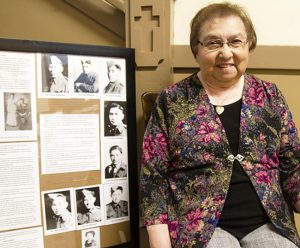
Doreen Ballendine Gilles of Battleford, Saskatchewan was just five-years-old when the Second World War began, and 11 when it ended. But she clearly remembers waving goodbye to her eight older brothers at the train station as, one by one, they left home to join the army. Sadly, there is little recorded history of this remarkable family, although the local Fred Light Museum, owned by the Town of Battleford, features a nice photo display.
The family’s impressive service record begins with her father, John Ballendine, and his older brother James. Both earned fame as crack snipers in the Great War. They were indigenous, much like the snipers in Joseph Boyden’s well-known novel called Three Day Road.
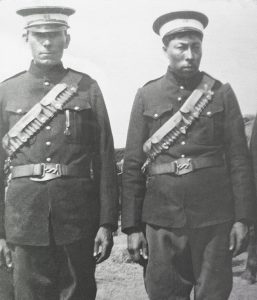
This photo shows James on the left, and John on the right.
Their original name wasn’t Ballendine. Their father was Frederick Ermineskin of Hobbema, Alberta. But Frederick chose the surname of his adoptive father Peter Ballendine, because he admired the Scottish fur trader.
Frederick moved to Saskatchewan and married a local Métis girl named Sophie Gardiner Cardinal. They had two sons – James, born in 1882; and John, born in 1883.
On November 20, 1906 John married a beautiful young girl named Marie Adelaide Oullette, born in Duck Lake, Saskatchewan on November 24, 1891. John was 23-years-old, and Marie just four days shy of her 15th birthday.
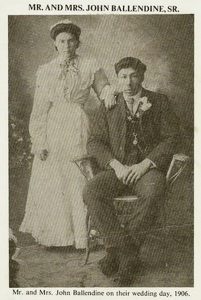 This photograph (left) appeared in the local newspaper, The Saskatchewan Herald.
This photograph (left) appeared in the local newspaper, The Saskatchewan Herald.
The young couple spent three years farming in the area before moving back to Battleford where John worked for a federal survey crew. Marie bore five sons, one of whom died in childhood.
In 1914, John bid his young family farewell and headed overseas to fight the Hun, along with his older brother James.
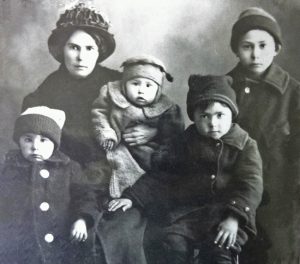 Here’s a photo of the family he left behind: Frank, Marie, Wilfred, John and Thomas.
Here’s a photo of the family he left behind: Frank, Marie, Wilfred, John and Thomas.
John enlisted in the 32nd Battalion and transferred to the 8th Battalion of the 90th Winnipeg Rifles. He was sent to France and established a record as a sniper, received several medals, and was mentioned in dispatches. He is credited with killing 36 Germans. “He had 36 notches on his belt,” Doreen said.
Wounded in 1916, John spent six months recovering in Scotland before being invalided home. After recuperating, he rejoined the Canadian Engineers but before he got back to France, the war ended.
His brother James had joined the 22nd Saskatchewan Light Horse in 1911, and left with the first contingent in August 1914. He also transferred to the 8th Battalion, 90th Winnipeg Rifles, where he became a top battalion sniper. He was also severely wounded on April 13, 1916 during the second battle of Ypres, and after a long convalescence was invalided home.
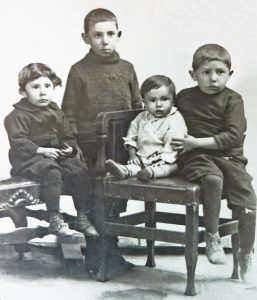
James became the town shoemaker. He married Annie Clara Sauve and had five daughters and one son, Mahoney Joseph Ballendine, who also served in the Canadian Army during the Second World War.
While John was away, Marie worked hard to raise her four little sons, all of whom became very independent and self-reliant. When her husband finally came home, he returned to survey work and family life. The couple had another five sons, but again, one of them died in childhood.
After a long wait, the family was finally blessed by a little girl in 1935, named Doreen. Her eldest brother Thomas was 24 years older than her, and there was a 10-year gap between her and the youngest son Walter. Needless to say, her parents and brothers doted on her.

Here’s a photo of John and Marie, looking very distinguished, with their two youngest children, Doreen and Walter.
The Ballendine brothers were handsome, strong, athletic boys and six of them played on the Battleford Sunrise Millers hockey team. John Junior even travelled to Japan with the team in 1936 – the first Canadian hockey team to play in Japan. Wearing red and gold jerseys, the team played 20 exhibition games to much fanfare from the Japanese.
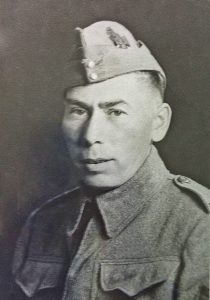
Three years later, World War Two was declared. The brothers were determined to carry on the family tradition, and join the Canadian Army. “They all decided they were going, and that was it,” Doreen recalls. “Nobody could stop them.”
Happily, although five of the eight Ballendines served overseas, none of them was killed.
Here, listed from oldest to youngest, are the eight brothers.
Sergeant Tom Ballendine enlisted in June 1940 with the Regina Rifles and was discharged in Debert, Nova Scotia, when the regiment went overseas. He served two years.
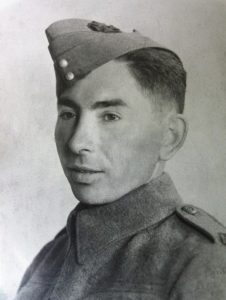

Private John F. Ballendine enlisted in Regina in May 1943 and went overseas with the Canadian Infantry in 1944.
Rifleman Frank S. Ballendine enlisted in the Regina Rifles in June 1940 and was honourably discharged after six months.

Private Wilfred Ballendine enlisted in the Royal Canadian Medical Corps in 1943, and went overseas in February 1944.

Company Sergeant Major Edward C. Ballendine enlisted in June 1940 with the Regina Rifles. He went overseas as a sergeant and was promoted to company sergeant major in England. In June 1943 he volunteered to go to Italy, and was transferred into the Princess Patricia’s Canadian Light Infantry.
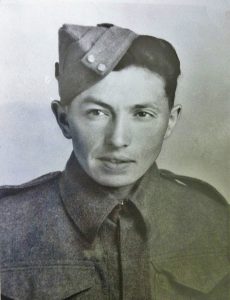
Corporal Paul Ballendine enlisted in February 1942. He was posted to Guelph and Listowel, Ontario, as an instructing corporal in infantry tactics and was honourably discharged in 1943.
Lance Corporal Benjamin R. Ballendine enlisted in June 1940 and went overseas with the Regina Rifles.
With his brother Edward, he went to Italy in June 1943 and was attached to the Loyal Edmonton Regiment.
He was a well-known sniper during the war.
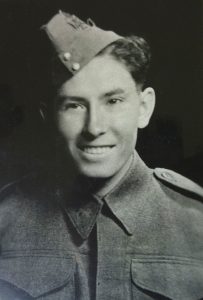
Private Walter E. Ballendine, the youngest son, joined the army at age seventeen. He was made an instructing corporal and was stationed at Prince Albert for two years.
When old enough to go overseas, he gave up his stripes and joined the Royal Canadian Medical Corps in May 1943. He finished serving in Holland.
The boys, when they were away from home, always mentioned their little sister.
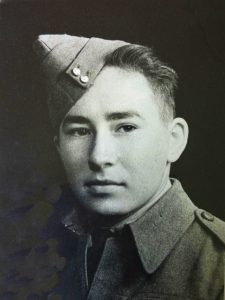
Here’s a brief letter from second-eldest son John, just before he shipped out.
Debert, Nova Scotia
November 4, 1944
Dear Mother, father, bros and Sis:
Just a few lines to let you know that I am fine, hoping you folks are the same. We had our final medical today, so folks I guess it is within a day or so that we move from here. Maybe by the time you get this I’ll be there, so mother keep your chins up as it will not be long now that will all be marching back home for good. I haven’t much to say. I am sending you a picture I took last night. So long for now, folks, hope to be hearing from you soon.
Your loving Son and brother, Johnny
X Kiss for sis
It is frightening enough to have one son in uniform – John and Marie had eight of them, five of whom served overseas. Their strong faith was a comfort, and they were devoted members of St. Vital’s Roman Catholic Church in Battleford all their lives.
All the Ballendine boys finally “came marching back home for good,” as Johnny predicted in his letter, although Doreen said that Benjamin suffered badly from what was then called shell-shock (now known as post-traumatic stress disorder) and was never the same carefree boy again.
Doreen, now aged 81, is the last surviving member of her immediate family. She married Clem Gilles and has nine children of her own.
One of Doreen’s fondest memories of her brothers is this act of kindness.
“While they were away from home, they decided I should learn to play the piano, so they all sent money from their soldier’s pay and told Mother to buy me a piano, and have me take lessons. They told me that when they got back, they wanted to hear me play ‘Life in the Finland Woods’.” (The piece is also known as Mocking Bird Hill.)
Doreen didn’t disappoint them. Her mother bought the piano, and Doreen practiced so hard that she even won the Amateur Hour talent competition, held at the Battleford Town Hall.
And when the boys came home, their little sister proudly performed “Life in the Finland Woods” for them. It was one of her happiest moments.
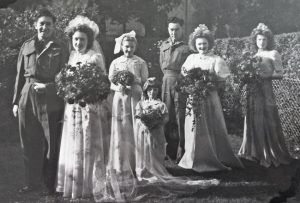
And in a stunning sequel to this story: When Ben Ballendine was stationed in England, he married an English girl. Here is his wedding photo, with his brother Wilfred as best man.
Ben left for Canada without ever seeing his son Colin, born nine months after the wedding. The marriage dissolved and five years later, the young mother married a man named Jim Payne, who adopted Colin and gave him the last name of Payne.
It wasn’t until 2008 that Colin Ballendine Payne tracked down his Canadian family and learned from his aunt Doreen that he had indigenous blood.
“I remember thinking how disloyal I had been as a child going to Saturday morning cinema and cheering on the cavalry as they raced to save some unfortunate wagon train!”
Even more surprising to Colin was the news that all the Ballendines had served in the Canadian Army, including Colin’s uncles and grandfather.
That’s because Colin himself served in the British Army for nine years, serving in Aden, Malta, Bahrain, and Northern Ireland.
“When I found out that all the Ballendines had served in the army, including both my father and grandfather, I wondered if there wasn’t something genetic in my strong attraction to the armed forces.”
 Here is a photo of Ben and Colin, the son he never met, showing the strong family resemblance.
Here is a photo of Ben and Colin, the son he never met, showing the strong family resemblance.
Finally, when Colin’s own son Ian was 18-years-old, you guessed it – he joined the British Army! Ian served six years in the Gulf and Northern Ireland. He makes up the fourth generation of the Ballendines to serve in the armed forces.
Whatever path they choose in life, all the descendants of the original brothers James and John Ballendine of Battleford, Saskatchewan, can be justly proud of their famous family — The Fighting Ballendines.
 – The Ballendine story is one of 28 interviews with World War Two veterans in a new book by bestselling author Elinor Florence of Invermere, titled My Favourite Veterans: True Stories of World War Two’s Hometown Heroes. Most of the veterans are men and women whom Elinor interviewed personally, and whose stories appeared previously on E-Know, including Cranbrook’s own Bud Abbott and Jim Ashworth of Invermere. To order your copy, email Elinor at [email protected] or call her at 250-342-0444.
– The Ballendine story is one of 28 interviews with World War Two veterans in a new book by bestselling author Elinor Florence of Invermere, titled My Favourite Veterans: True Stories of World War Two’s Hometown Heroes. Most of the veterans are men and women whom Elinor interviewed personally, and whose stories appeared previously on E-Know, including Cranbrook’s own Bud Abbott and Jim Ashworth of Invermere. To order your copy, email Elinor at [email protected] or call her at 250-342-0444.
Elinor’s first historical novel has reached national bestseller status. Bird’s Eye View is about a Saskatchewan farm girl who joins the Royal Canadian Air Force and becomes an aerial photographic interpreter. The book is available through any bookstore, or as an ebook. For more info, visit Elinor’s website at www.elinorflorence.com.







